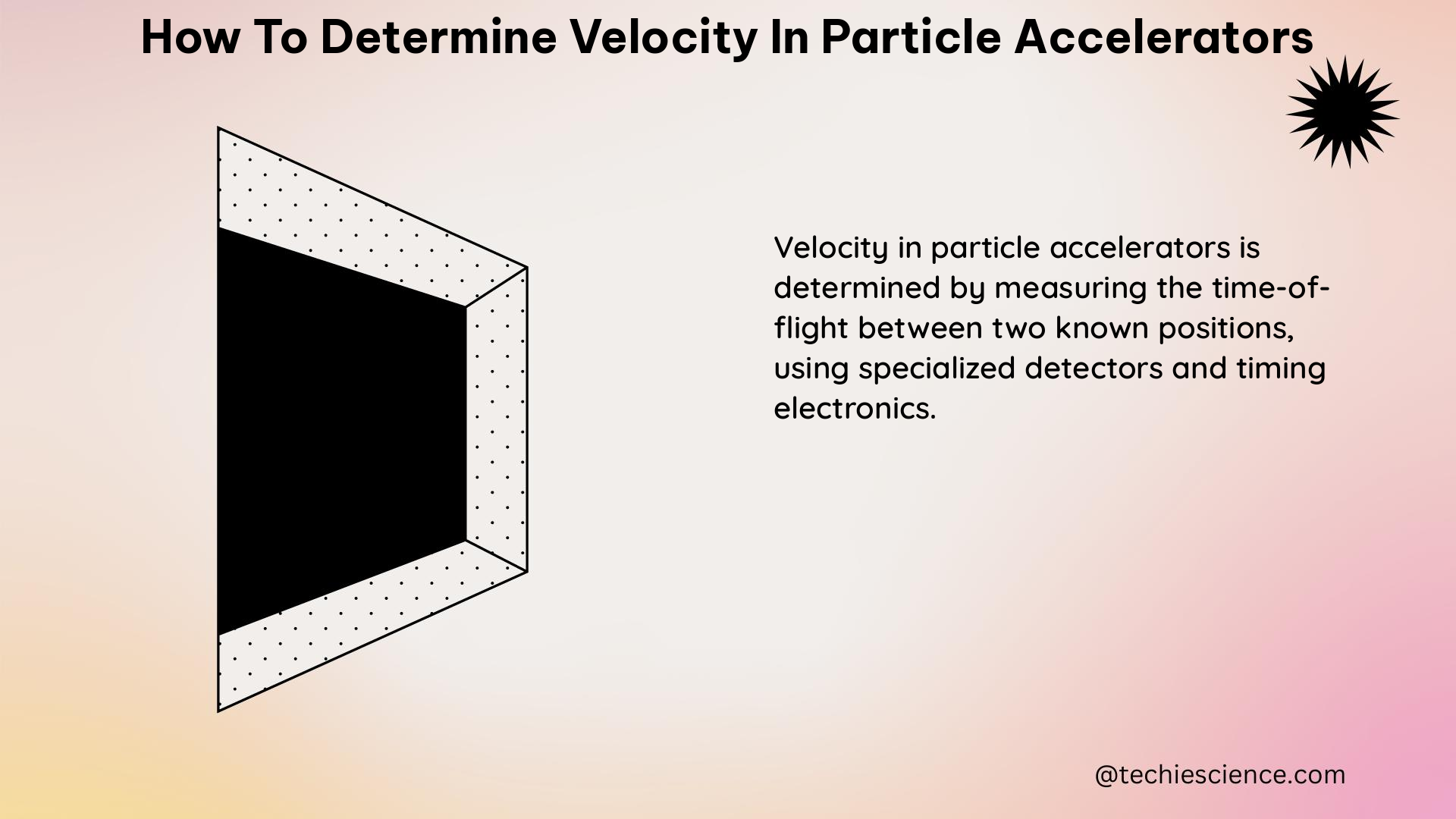In the realm of particle physics, accurately measuring the velocity of particles within particle accelerators is crucial for understanding the fundamental behavior of matter and energy. This comprehensive guide delves into the various methods and theoretical concepts employed to determine the velocity of particles in these advanced scientific instruments.
Measuring Particle Velocity Using Energy and Relativistic Formulas
One common approach to determining the velocity of particles in particle accelerators is to measure their energy and then use the relativistic formulas to calculate the velocity. The two primary equations used in this method are:
- Energy-Velocity Relationship (Relativistic): $E = mc^2$ or $E = \frac{1}{2}mv^2$
- Where $E$ is the energy of the particle, $m$ is the mass of the particle, and $c$ is the speed of light.
- By rearranging these equations, the velocity of the particle can be calculated as: $v = \sqrt{\frac{2E}{m}}$
However, this method requires choosing between Galilean and special relativity, and it cannot be used to verify either of them. Additionally, the energy measurement alone does not provide a direct verification of the particle’s velocity.
Measuring Particle Velocity Using Oscillating Electric Field Frequency

In the case of the Large Hadron Collider (LHC), the velocity of the particle beam can be measured independently of the energy by using the frequency of the oscillating electric field that is applied to accelerate the protons. This method takes advantage of the following principles:
- The frequency of the oscillating electric field is directly dependent on the rate at which bunches of protons pass the acceleration points.
- The rate at which the bunches pass the acceleration points is, in turn, dependent on the speed at which the bunches are traveling.
- The LHC is able to accelerate the proton bunches using a constant-frequency oscillating electric field, which means that the protons are traveling at a constant speed regardless of their energy.
This approach aligns with the predictions of special relativity, as the protons maintain a constant velocity throughout the acceleration process.
Measuring Particle Velocity Using Time-of-Flight Technique
Another method for determining the velocity of particles in particle accelerators is the time-of-flight (TOF) technique. This approach involves:
- Measuring the time it takes for a particle to travel a known distance.
- Using the formula $v = \frac{d}{t}$ to calculate the velocity, where $v$ is the velocity, $d$ is the distance traveled, and $t$ is the time taken.
This method can be used to measure the velocity of individual particles within a beam, as well as the velocity of the beam as a whole. It provides a direct measurement of the particle’s velocity, independent of energy or other indirect factors.
Theoretical Concepts and Formulas for Understanding Particle Velocity
In addition to the experimental methods, there are various theoretical concepts and formulas that can be used to understand the behavior of particles in particle accelerators:
- Lorentz Transformation: The Lorentz transformation can be used to relate the velocity of a particle in one reference frame to its velocity in another reference frame. This is particularly useful when analyzing the motion of particles in different coordinate systems.
-
Example: If a particle has a velocity of $0.9c$ in one frame, its velocity in another frame moving at $0.5c$ relative to the first frame would be $0.97c$.
-
Relativistic Mass: The concept of relativistic mass can be used to understand how the mass of a particle changes as its velocity approaches the speed of light.
- Example: A proton with a rest mass of $1 \text{ GeV}/c^2$ and a velocity of $0.99c$ would have a relativistic mass of approximately $7 \text{ GeV}/c^2$.
These theoretical concepts and formulas provide a deeper understanding of the underlying physics governing the motion of particles in particle accelerators.
Quantifiable Data and Values
Here are some additional quantifiable data points and values related to the measurement of velocity in particle accelerators:
- LHC Proton Injection: In the LHC, protons are injected into the ring in “bunches” of a few hundred billion each, with an initial energy of around $450 \text{ GeV}$.
- LHC Electric Field Frequency: The frequency of the oscillating electric field at the LHC is $400 \text{ MHz}$, which is constant regardless of proton energy.
- Time-of-Flight Example: If a particle travels a distance of $1 \text{ meter}$ in $1 \text{ nanosecond}$, its velocity would be $1 \text{ meter per nanosecond}$, or $1 \text{ Gm/s}$.
These data points and values provide a more concrete understanding of the specific parameters and measurements involved in determining the velocity of particles in particle accelerators.
Conclusion
In summary, this comprehensive guide has explored the various methods and theoretical concepts used to determine the velocity of particles in particle accelerators. From measuring the energy and using relativistic formulas to leveraging the frequency of oscillating electric fields and the time-of-flight technique, particle physicists have a robust set of tools at their disposal to accurately measure and understand the motion of these fundamental building blocks of the universe.
Reference:
- Particle Acceleration – an overview | ScienceDirect Topics
- Measurement of Velocity – ScienceDirect.com
- How is speed measured in the LHC – Physics Stack Exchange

The lambdageeks.com Core SME Team is a group of experienced subject matter experts from diverse scientific and technical fields including Physics, Chemistry, Technology,Electronics & Electrical Engineering, Automotive, Mechanical Engineering. Our team collaborates to create high-quality, well-researched articles on a wide range of science and technology topics for the lambdageeks.com website.
All Our Senior SME are having more than 7 Years of experience in the respective fields . They are either Working Industry Professionals or assocaited With different Universities. Refer Our Authors Page to get to know About our Core SMEs.